|
|
Florizel II

|
|
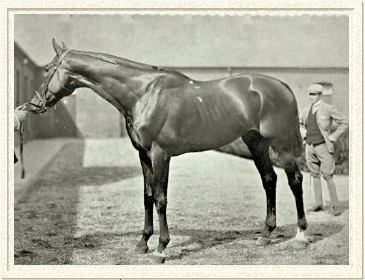 |
|
|
Florizel II was the eldest of three famous brothers; the other two were the great champion Persimmon (1893) and English Triple Crown winner Diamond Jubilee (1897), both winners of the Epsom Derby.
Their dam, Perdita II, was a good racemare who had begun life as a selling plater (the English equivalent of a claimer), and was sired by the important staying influence, Hampton. She had been purchased for 900 pounds on behalf of Albert, the Prince of Wales (the future King George V), by Lord Beresford, racing manager for the Royal family. While the Prince's mother, Queen Victoria, disapproved of the company her heir was keeping, the fact is that the success of his racing stable made him immensely popular with the common people, and the mare Perdita II made some of the most important contributions to that cause.
Florizel II was the third foal out of Perdita II, and the first of the three great brothers, all sired by the immortal runner and sire, St. Simon. A brown colt foaled in 1891, Florizel II was big, gawky, and immature as a two-year-old, which delayed his first start until late in the year. He was unplaced in his debut, the Manchester Autumn Breeders' Foal Plate behind the winner, St. Hilaire, then ran second in the Boscawen Stakes to winner Priestholme. In his third start, the Stand Nursery Plate, he was again unplaced, behind winner Bloodthirsty, and in his final juvenile start, was unplaced for a third time behind the winner, Go Lightly.
Given time to mature, Florizel II started his three-year-old campaign in June, breaking his maiden in the prestigious St. James' Palace Stakes over a mile at the Royal Ascot meeting. Returned to racing the very next day in the Ascot Triennial Stakes over a slightly shorter course (7f. 166 yards), Florizel II won again. He was victorious on three more occasions that season, the Corinthian Plate (a mile), Brighton High-Weight Handicap (a mile), and Royal Stakes (a mile and a quarter). This kind of record suggested he was considered a useful miler asked to stretch in his final start that season, but that picture shifted dramatically the next year.
As a four-year-old, Florizel II bloomed into an entirely different sort. He won his first five races, including the Prince of Wales' Plate (8f. Epsom), Prince's Handicap (10f., Gatwick), Manchester Cup (14f., Manchester), Ascot Gold Vase (2 miles, Ascot), and Goodwood Cup (2 1/2 miles, Goodwood). He seemed to improve with every start, and especially as the distances increased. In the Cesarewitch Stakes, his sixth start of the season, he was returning after a long layoff but could only run fourth behind Rockdove, Bird of Avon, and Count Schomberg, giving all three great weight advantages. In his final start of the year, he faced only one other runner in the Jockey Club Cup (2 _ miles, Newmarket), and won by four, defeating the accomplished mare None the Wiser.
At five, Florizel II only started once, making his return engagement in the Ascot Gold Cup, in which he ran third behind Love Wisely and Omnium II. Problems with his suspensory ligaments forced his retirement from racing and a new life as a stallion, after 11 wins in 22 starts.
While Florizel II was peaking as a four-year-old, his two years younger brother, Persimmon was making a name for himself as one of the better juveniles in training with wins in the Coventry Stakes and Richmond Stakes. At three, while Florizel II was struggling as a five-year-old to remain in training, Persimmon's brilliant wins in the Derby, St. Leger, and Jockey Club Stakes overshadowed all and brought glory to the Royal Family. The next year, the four-year-old Persimmon accounted for the Ascot Gold Cup and Eclipse Stakes as well, and retired to a great career as a stallion alongside his older brother at Sandringham.
Florizel in the Stud
Florizel II's own career as a stallion at Sandringham was not as remarkable, but he left a strong impression nonetheless.
|
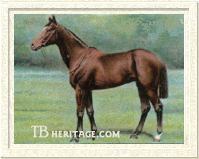
Volodyovksi
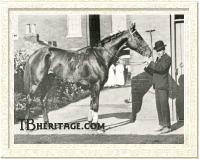
Doricles
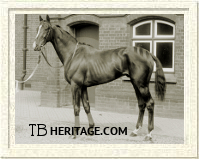
Anmer
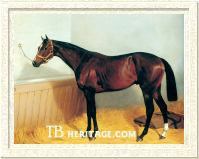
Mackintosh won the Prince of Wales Nursery Plate and Ascot's Gold Vase
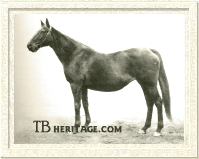
Princess Sterling was a winner and dam of 2,000 Guineas winner St. Louis; she was sold to W.J. Salmon in the U.S. at age 12
| |
From his first crop came VOLODYOVSKI, winner of the 1901 Derby Stakes and DORICLES, winner of the St. Leger that same year. These two classic wins were noteworthy in and of themselves, especially for a first-crop sire. They were even more notable because the previous year these same races, and the 2,000 Guineas, had been won by Florizel II's younger brother Diamond Jubilee. [Diamond Jubilee also retired to stud at Sandringham, but was sent to Argentina in 1906, where he became a very important stallion.]
Besides Volodyovski and Doricles, Florizel II sired the classicists ROYAL ARCH, victorious in the Irish Derby in 1904, and VEDAS, winner of the 2,000 Guineas in 1905.
His other noteworthy runners included MACKINTOSH, FULMEN, FLOREAL, and the ill-fated ANMER, who was the target in the infamous suffragette incident in the 1913 Derby, won by Aboyeur. During the running of the race, Miss Emily Davidson ran out on to the course and grabbed Anmer's bridle, pulling him down. The horse recovered, while the lady, unfortunately, did not. Anmer was sent to stud in Canada and included among his offspring the 1925 Kings' Plate winner Fairbank, a filly.
Volodyovski (1898) was not an effective stallion son for Florizel II, although he did sire the Italian Derby winner Manistee. Florizel's best sire son was probably Doricles (1898), who got the moderate French runner Consols (1908), himself sire of the very good runner Massine (1920). Massine proved an important stallion in France, getting Mieuxce, Strip the Willow, Sultan Mahomed, Blue Moon, and Maravedis among others.
Florizel II's son, Fulmen (1907) retired to stud in Argentina and his line survived through Fulmen's son, Leteo (1917), as well as the important mares La Luz and Entidad. Leteo's sons included Mineral and Puro Habano. Another Florizel II son, Floreal (1908), was sent to Russia, where he got Tagor (1915), sire of Granit II (sire of Zagar) and Zator. Florizel II also had useful sire sons in Mackintosh and Southannan.
Daughters of Florizel II proved good broodmares. The most important of these was GEMMA (1903), who foaled the outstanding French runner and sire Sardanapale (1911) by Prestige. Another important daughter was GOLDSCLEUGH (1906), dam of the influential broodmare Golden Harp (by Llangibby).
Other daughters of Florizel II included PRINCESS STERLING, dam of 2,000 Guineas winner St. Louis (by Louvois); and LADY QUEX, dam of Lord Quex (1917) by Lemberg. Both Princess Sterling and Goldscleugh were foundation mares in the Confey Stud of Irish breeder J.J. Maher.
Florizel II was a big horse, fully 16.2 hands, a brown with white ankles on his left front and left hind. In Richard Ulbrich's The Great Stallion Book, he quotes a description of the horse with "very true formation." The accompanying photo of him indicates he was a scopy individual, standing on long legs over a lot of ground, with a long, powerful neck, outstanding shoulder and hindquarter. While he had a long forearm and short cannon, he appears to be over at the knee (typical of St. Simon's get), and slightly upright in the pasterns. This may account for his suspensory problems later in his racing career, although he was very tough and resilient during his first three seasons of racing.
|
Florizel II also appears to be a more attractive horse than his brother Persimmon, who had a plain head and lop ears. Florizel II was also more substantial in build than the other brother, Diamond Jubilee, and certainly not endowed with the latter's terroristic temperment.
--Anne Peters
|
|
|
|

